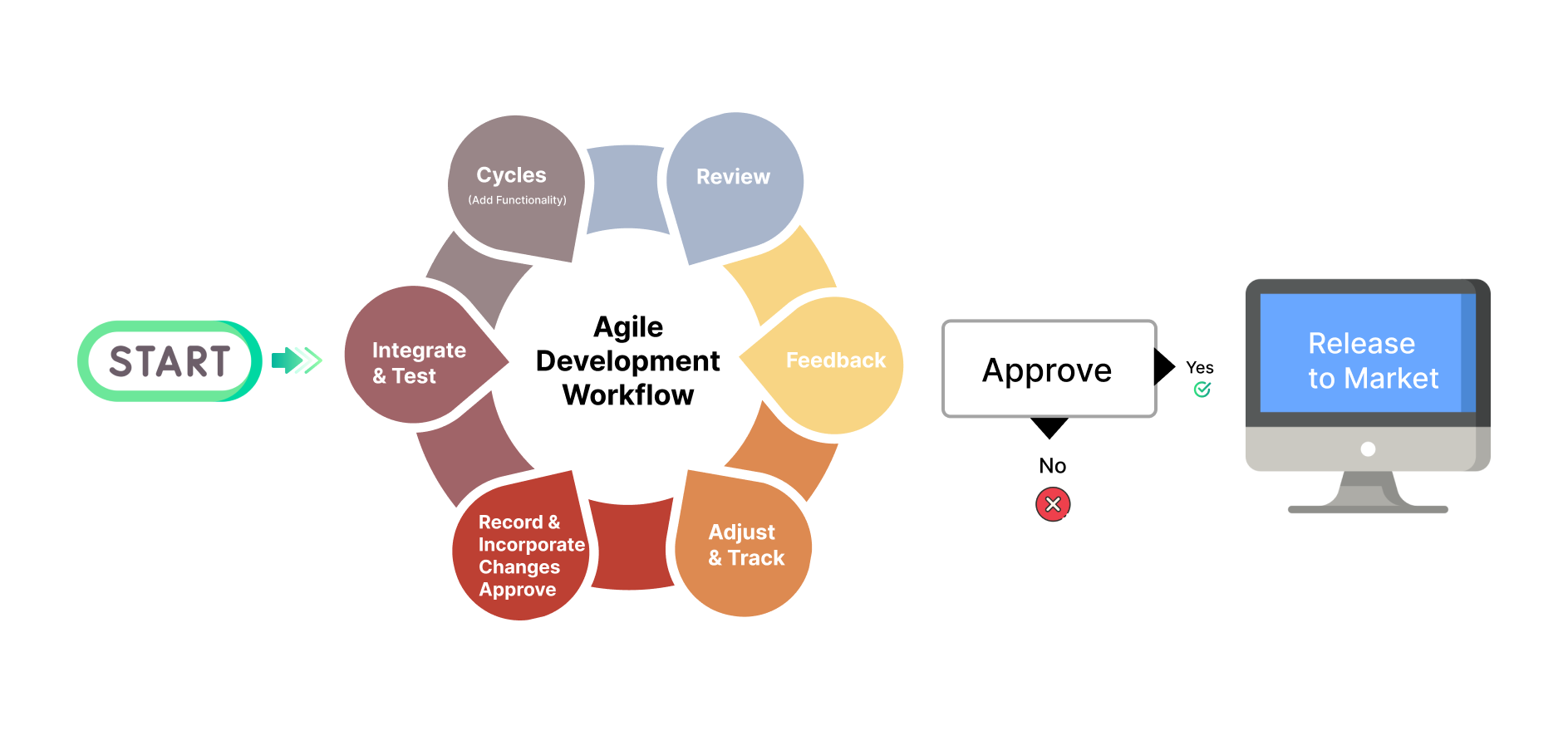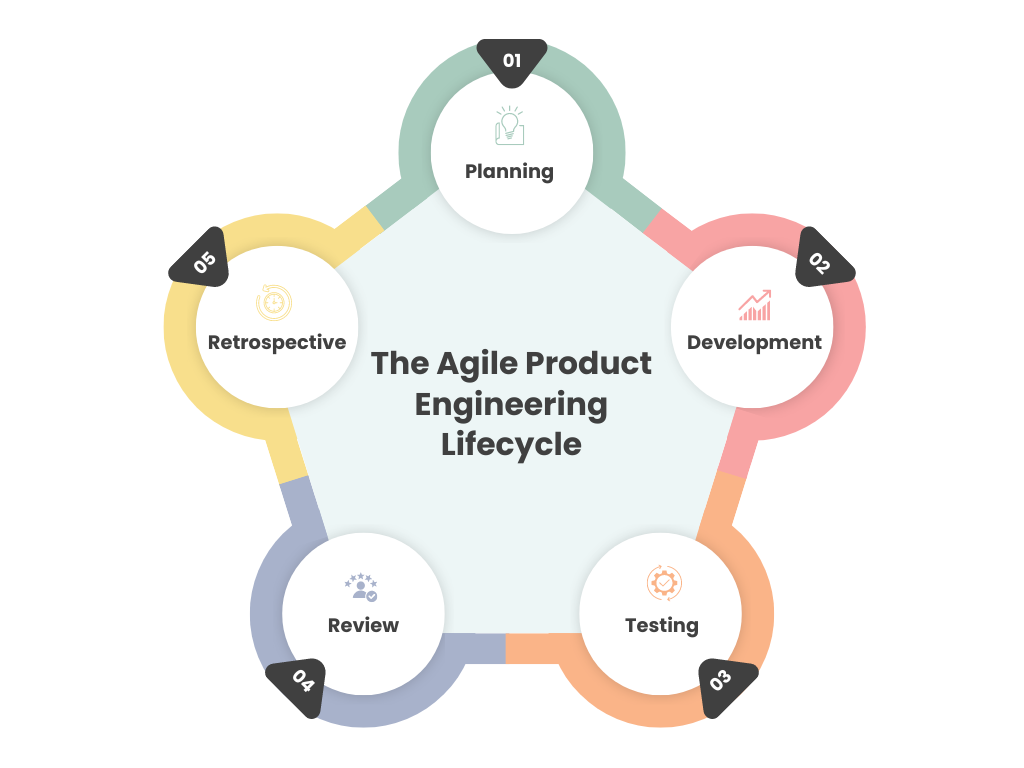In modern software development, businesses need strategies that allow them to adapt quickly to changing market demands and customer needs. Traditional development models, such as the waterfall method, often fail to meet the dynamic requirements of today's digital landscape. Agile Product Engineering provides an effective, collaborative approach that has become critical for efficient software development. By utilising Agile methodologies, teams can improve product quality, reduce risks, and accelerate the delivery of software products.

What is Agile Software Development?
Agile Software Development is a methodology centred on delivering functional software through iterative, incremental cycles called "sprints." In each sprint, development teams build small, manageable portions of the product, test them, and incorporate stakeholder feedback before moving to the next iteration. This flexible approach contrasts with the traditional waterfall model, which follows a linear sequence of phases, often leaving no room for changes once a phase is completed.
The Agile Manifesto defines key principles of Agile development, focusing on individuals and interactions, working software, customer collaboration, and adaptability to change. These core principles make Agile Software Development a widely adopted framework in today’s software engineering landscape.
The Role of Agile Product Development in Today’s Competitive Market
Agile Product Development plays a crucial role in helping businesses respond quickly to market changes. Unlike traditional product development cycles, which often take months or even years to complete, Agile splits the process into shorter iterations, typically two to four weeks long. These iterations, or sprints, allow teams to deliver working software more frequently, making it easier to incorporate real-time feedback and course corrections as needed.
The flexibility provided by Agile Product Development not only helps teams adapt to evolving customer requirements but also reduces the risk of failure. Early identification of issues through continuous testing and feedback loops ensures that necessary adjustments can be made during the development process, ultimately leading to more successful project outcomes.
Key Benefits of Agile Development for Software Engineering
Agile Development provides several key benefits that make it a preferred methodology in software engineering:
- Faster iteration cycles: Agile teams work in short sprints, allowing them to deliver working software more frequently, which speeds up the time-to-market.
- Improved collaboration: Agile emphasises constant collaboration between cross-functional teams, stakeholders, and customers, ensuring the project stays aligned with business objectives.
- Reduced risk: By continuously testing and refining the product in each sprint, teams can identify and address issues early, significantly lowering the risk of major project failures.
- Enhanced product quality: Frequent testing and feedback loops enable teams to improve product quality throughout the development lifecycle.
Agile Engineering Practices that Drive Efficiency
To achieve efficiency and maintain high-quality standards, Agile Engineering Practices play an essential role in the development process. Key practices include:
- Continuous Integration (CI) and Continuous Delivery (CD): These practices automate testing and deployment, ensuring that teams can release new features quickly and with minimal errors.
- Test-Driven Development (TDD): TDD requires developers to write tests before writing the actual code, catching potential defects early and improving software reliability.
- Pair Programming: In this method, two developers work together on the same piece of code, leading to higher code quality due to real-time review and collaboration.
By integrating these Agile Engineering Practices, development teams can enhance efficiency and maintain continuous improvement throughout the project lifecycle.
Agile Development Methodologies: Scrum vs Kanban
Two of the most common Agile Development Methodologies are Scrum and Kanban:
- Scrum: This methodology structures work into short sprints, usually lasting two to four weeks. Daily stand-up meetings help track progress, and teams hold sprint retrospectives to review what worked and what needs improvement. Scrum is widely used in teams that require defined roles, accountability, and clear sprint goals.
- Kanban: Unlike Scrum, Kanban is more flexible and focuses on visualising the workflow through a board. There are no fixed-length sprints, and teams work on tasks as they come, focusing on minimising work-in-progress. Kanban is ideal for projects requiring continuous delivery without strict time constraints.
Both methodologies promote flexibility, but the best choice depends on the specific needs of the project and the team.
Why Agile is Essential in Software Engineering
Agile methodologies have become critical in software engineering because they streamline the development process and enhance productivity. By breaking projects into smaller sprints and continuously incorporating feedback, Agile ensures that teams remain focused on delivering high-value software without compromising quality.
Collaboration is also central to Agile, ensuring that developers, designers, and stakeholders are always aligned. This reduces misunderstandings and scope creep, ultimately leading to faster, more efficient project delivery and higher customer satisfaction.
Benefits of Agile Development in Handling Complex Projects
Managing complex projects requires adaptability and responsiveness, which Agile Development excels at providing. By breaking down large projects into smaller, manageable tasks, Agile helps teams maintain focus and stay organised. Each sprint addresses specific challenges, allowing the team to make continuous improvements.
Agile’s iterative approach also allows for frequent assessment of progress, enabling teams to address unexpected challenges and pivot as necessary. This flexibility is especially valuable in complex projects, where requirements can change frequently due to evolving market conditions or customer needs.
The Agile Product Engineering Lifecycle
The Agile Product Engineering Lifecycle follows an iterative approach aimed at continuous improvement. The key phases include:

- Planning: The team identifies project goals, defines the product backlog, and determines the scope of work for the upcoming sprint.
- Development: This phase involves designing and coding the product increment for that sprint.
- Testing: Testing is conducted throughout the sprint to ensure the product is functional and meets quality standards.
- Review: At the end of each sprint, the team reviews the completed work with stakeholders to gather feedback for future iterations.
- Retrospective: The team reflects on what went well and identifies areas for improvement in the next sprint.
This cyclical process allows teams to release functional software more regularly and ensures that they are continuously delivering value to customers.
How Agile Software Development Ensures Customer Satisfaction
A core strength of Agile Software Development is its ability to keep the customer’s needs at the forefront. By delivering functional software in small, frequent increments, Agile teams can gather feedback early and often, allowing them to make adjustments before larger issues arise. This ensures that the final product is aligned with customer expectations.
The iterative nature of Agile also means that the product is always evolving, based on real-time feedback. This constant refinement leads to higher levels of customer satisfaction, as the software remains aligned with users' needs.
Agile Product Development and Risk Management
Agile Product Development excels at risk management by addressing potential issues early in the process. Traditional models often struggle with risk due to their linear structure, where problems may not surface until late in the project. Agile’s continuous testing and feedback loops ensure that risks are identified and mitigated in real time.
Additionally, Agile’s flexibility allows teams to pivot quickly in response to changing conditions, reducing the overall risk of project failure. This adaptability is a key reason why Agile development is so successful in managing risk.
Agile Engineering and Scalability
Agile Engineering is inherently scalable, making it suitable for both small startups and large enterprises. For larger teams, Agile can be scaled using frameworks such as the Scaled Agile Framework (SAFe) or Large Scale Scrum (LeSS). These frameworks allow organisations to maintain the core principles of Agile, such as collaboration, flexibility, and incremental delivery, while handling the complexities of larger projects.
This scalability ensures that Agile practices can be implemented effectively, regardless of the team size or project scope.
The Future of Agile in Software Engineering
As the field of software development evolves,Agile methodologies will continue to play an essential role. Emerging technologies such as Artificial Intelligence, Machine Learning, and DevOps are further enhancing Agile practices by enabling faster deployments, smarter decision-making, and better automation.
Looking forward, Agile development will continue to provide the flexibility needed to stay competitive in a rapidly changing market. The adaptability of Agile ensures its relevance in modern software engineering, where businesses must quickly respond to evolving customer demands and technological advancements.
Conclusion
In conclusion, Agile Product Engineering is critical for achieving efficient software development. By embracing Agile methodologies, businesses can enhance flexibility, accelerate product delivery, and continuously meet customer expectations. Agile’s iterative and collaborative nature allows for early risk identification, continuous product improvement, and alignment with market needs.
For companies seeking to implement Agile practices, Acropolix provides expert consultation in software development, helping teams streamline their processes, improve productivity, and ensure successful project outcomes. Through our extensive experience in Agile product engineering, we help businesses leverage the power of Agile to deliver high-quality software solutions faster and more efficiently.
To learn more about our services, visit Acropolix's product engineering page.



